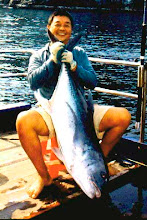 |
| This article was published in the June 2002 issue of Rod & Line Fishing Magazine. |
When I saw the small pond (about
the surface area of eight ping-pong tables), my heart sank. At that time I put
on a very enthusiastic look so as not to disappoint my friend, Mong. You see it
was he who, while biking over some hills, discovered this pond. Tucked away in
a secluded valley, and partly obscured from the general view, it looked like a
very promising snakehead habitat. His description of the place was so enthusiastic
and exciting that images of giant haruans and bujuks kept leaping up in my
mind. A trip was arranged in no time and thus saw Mong and me standing near the
edge of the pond.
 |
| Side view of the Channa gachua. The fins were fringed with red, with greenish hue on other parts, quite similar to the fighting fish. |
At first cast, my frog was tapped
a few times with no hook-up. The tiny cluster of bubbles that broke the surface
of the water betrayed the snakeheads. The funny thing was no matter where we
cast, the same old tap, tap was the usual fare.
“Cheroots,” I declared and Mong nodded in agreement.
As anglers we were not satisfied
without landing and having a look at the culprits. Thus changing to smaller
hooks and putting on the smallest frogs, we immediately landed two 10cm long
babies. I almost threw mine back in when I was bitten by it. Taking a closer
look at this gutsy fellow, I saw the unmistakable red and green fins. “Gachua’”
I shouted.
 |
| Top view of the Redtail snakehead. The head was a bit rounded and flat. |
Mong gave me a confused look. I
explained to him that the fish looked like the Channa gachua or the red tailed
snakehead recently discovered by the Rod & Line Guinness team.
All in we both managed to catch
and released more than ten fish. Immediately upon reaching home. I referred to the
April 2000 issue of R & L, and true enough, it was the Channa gachua.
That night, while having our
usual coffee session, we let the others into our discovery. The excitement was
pervasive and we immediately planned another trip.
 |
| James and Poh Yean holding their tiny catches. |
When one guy asked how much was
the red tail worth in the aquarium shop, all of us gave him the murderous
looks. The cold steely stares must have done their job well for he dared not even
mention the topic again. Needless to say, he was not among the gang on the next
trip.
 |
| Siew Mooi with her gachua. |
The next Sunday, James, Miss
Cheah Poh Yean, Mong, my wife (Siew Mooi) and I were in James’ Ford Splash,
rocking skidding, sliding and clawing up the hill. The ride was quite harrowing
as we watched with bated breath at James struggling to control the vehicle. Any
misjudgment would mean disaster with us at the ravine below. After what seemed
like eternity we finally lifted our sweat soaked buttocks off the car seats.
Upon the completion of the
unloading of our gears, we slowly picked our way down the slope. Following the
path that Mong and I had cut a week earlier. We made slow progress, as the
slope was quite steep and slippery. Along the way, I pointed out the tracks
made by the wild boars to the ladies. They (the wild boars) somehow always
follow the same track. The openings in the bushes made by the boars as they
enter and leave were their downfalls. These were the places where hunters set
up their ambushes. Someone excitedly suggested that we could catch some piglets
if we ground bait that place with oil palm fruits. We then told that someone,
that instead of piglets, a frustrated old boar with two sharp tusks could come
for dinner too (They cannot buy Viagra in the jungle, you know. Oh, I forgot
the Tongkat Ali).
 |
| Mong showing off his tiny fish. Behind him was the pond. |
This trip we let the ladies do
most of the fishing. From the grass-covered edge, my wife pulled out four red
tails. They were all taken with worms. Poh Yean caught six of them. Mong and I
were using very tiny lures and streamers with no positive result. The tiny
jewels were really ferocious. When the
worm-laden hook was lowered down the openings in the weeds, there would be a
ferocious take and the tiny snakehead would self-hook. When James tried to
unhook one of these miniature tigers, he was bitten by it. This chap refused to
let go even when pulled gently. There is a Chinese proverb that sounded like
this, “Yan sum pat chook , she ton cheong.” Translated into English it means ‘human heart
is never satisfied, like the snake trying to swallow the elephant’. That
ancient Chines guy who spoke these words must have been bitten by one too.
All in we caught twelve of those
rare snakeheads. As that pond was so small and the tiny gachuas were rare, we
decided to release five of them into some jungle streams. The rest were gently
set free in a marshy swamp. We sure hope our little effort would contribute to
the spread and preservation of this fish as that small patch of water that they
called home might dry up later.









